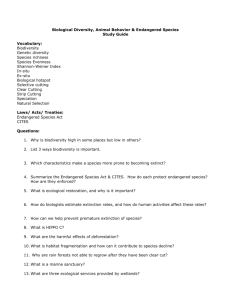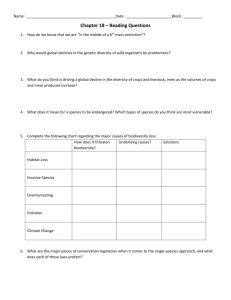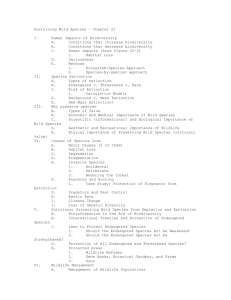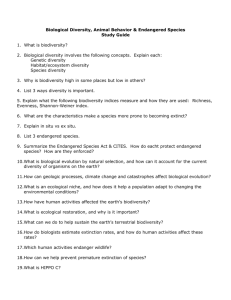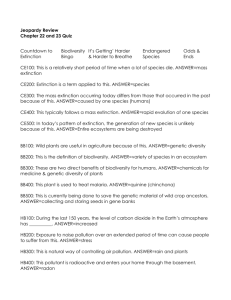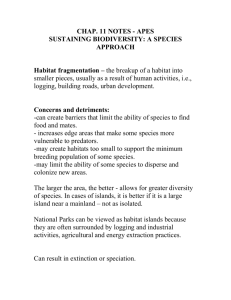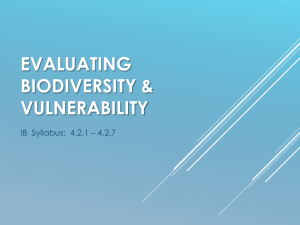CHAPTER 22: Sustaining Wild Species
advertisement
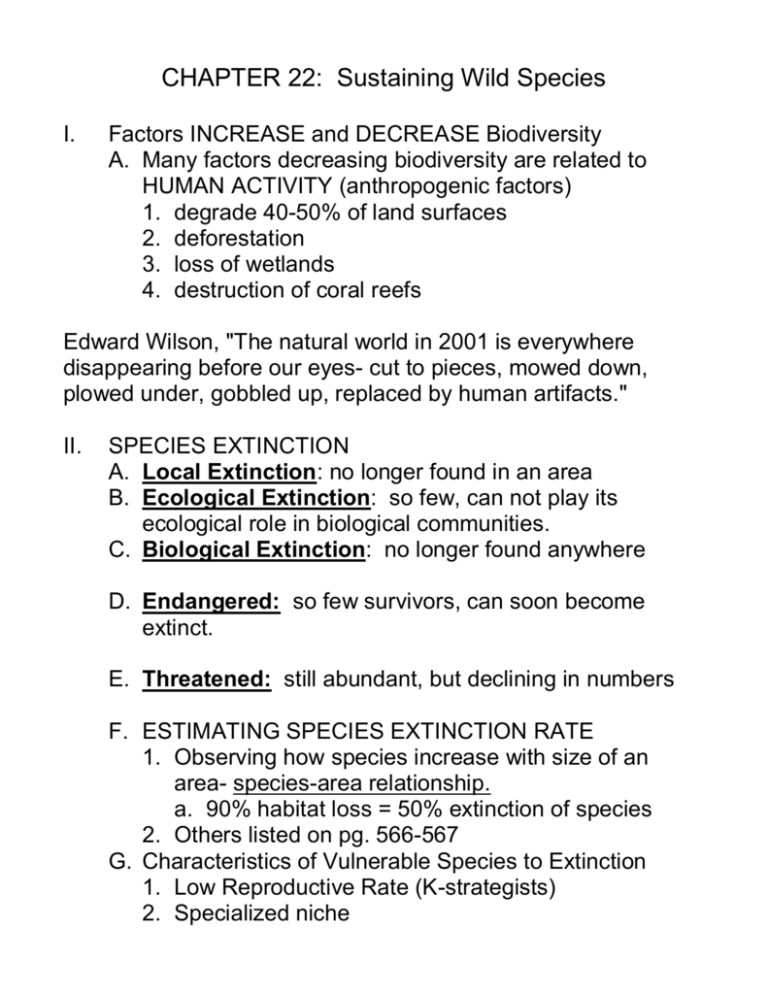
CHAPTER 22: Sustaining Wild Species I. Factors INCREASE and DECREASE Biodiversity A. Many factors decreasing biodiversity are related to HUMAN ACTIVITY (anthropogenic factors) 1. degrade 40-50% of land surfaces 2. deforestation 3. loss of wetlands 4. destruction of coral reefs Edward Wilson, "The natural world in 2001 is everywhere disappearing before our eyes- cut to pieces, mowed down, plowed under, gobbled up, replaced by human artifacts." II. SPECIES EXTINCTION A. Local Extinction: no longer found in an area B. Ecological Extinction: so few, can not play its ecological role in biological communities. C. Biological Extinction: no longer found anywhere D. Endangered: so few survivors, can soon become extinct. E. Threatened: still abundant, but declining in numbers F. ESTIMATING SPECIES EXTINCTION RATE 1. Observing how species increase with size of an area- species-area relationship. a. 90% habitat loss = 50% extinction of species 2. Others listed on pg. 566-567 G. Characteristics of Vulnerable Species to Extinction 1. Low Reproductive Rate (K-strategists) 2. Specialized niche 3. 4. 5. 6. 7. 8. Narrow distribution Top of food chain Migratory Small population size Commercially valuable Large Territories III. Why Should We Care? A. Instrumental Value (human centered): usefulness to us 1. Economic Goods: Species provide food, fuel, fiber, lumber, paper, medicine 2. Ecological: Sustain earth's biodiversity, and ecological functions supporting human economies and human health 3. Information: Genetic Information/engineering 4. Recreation: eco-tourism 5. Non-use: existence, aesthetic B. Intrinsic Value: Right to exist- period! IV. Causes of Extinction A. Underlying Causes 1. Population growth 2. Rising resource use 3. Poverty 4. No accounting for the environment B. Direct Causes 1. Habitat loss, fragmentation, degredation 2. Introduction of invader species (cane toads are coming!) a. Characteristics of successful invader species: i. r-selected species (high reproductive rate) ii. Long lived iii. iv. High dispersal rate Generalists 3. Others on pg. 572 V. International Treaties and Laws to Help Protect Endangered Species A. CITIES: Convention on International Trade in Endangered Species C. Lacey Act of 1900: prohibit transporting of live or dead wild animals or parts across state borders without permit D. Endangered Species Act 1973 (amended 1982, 1988): Illegal to trade or import and endangered or threatened species. VI. WILDLIFE MANAGEMENT A. Manipulating wildlife populations and their habitats for their welfare and for human benefit. B. Manage game species for sustainable yield. 1. regulations 2. harvest quotas 3. improve wildlife habitat 4. international treaties for migrating species (water fowl) NAME:__________________________________________ Miller Chapter 22: Sustaining Wild Species APES: Mr. Visconti 1. How do population growth, poverty and climate change affect biodiversity? 2. Discuss your true reaction to the following statement: "Eventually all species become extinct. Thus it does not matter that the passenger pigeon is extinct and that the blue whale, the whooping crane, the California condor, and the world's remaining rhinoceros and tiger species are endangered mostly because of human activities. " Be honest about your reaction, and give arguments for your opinion. 3. Your lawn and house are invaded by fire ants, which can cause painful bites. What would you do? Does it matter which type of species (k-selected, rselected)? 4. Environmental groups in a heavily forested state want to restrict logging in some areas to save the habitat of an endangered squirrel. Timber company officials argue that the well-being of one type of squirrel is not as important as the well-being of the many families affected if the restriction causes them to lay off hundreds of workers. If you had the power to decide this issue, what would you do and why? Can you come up with a compromise?



